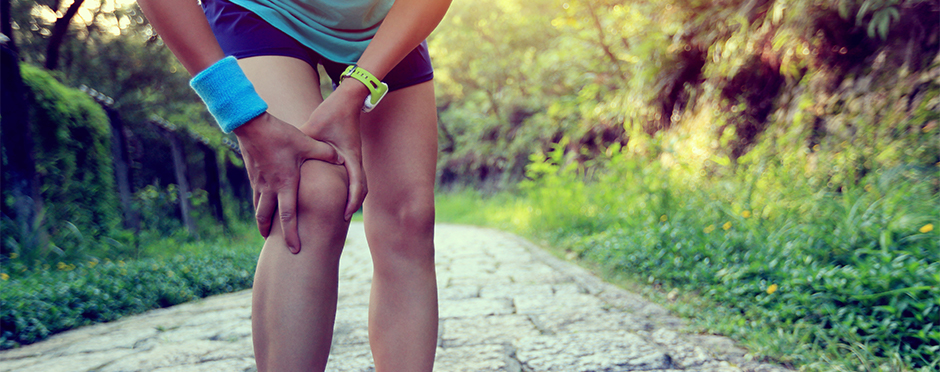
5 Ways to Stop Knee Pain in Runners
2 CommentsBetween 20 to 93 percent of runners suffer from knee pain, making it the most common lower extremity injury.2 When knee pain occurs, one of the treatment options is physical therapy. Physical therapists are trained to examine, diagnose and treat knee pain to help patients return to the activities they love.
The majority of knee pain associated with running is not caused by direct trauma but rather improper loading. Running requires the ability to absorb the weight of the body when the runner’s foot hits the ground in order to propel the runner forward. Although it might not seem like it, running is actually a complicated skill that most people do not actively practice prior to their recreational run. Knee pain can start during a run, but most commonly is experienced after running longer distances. Research shows the more miles you run the higher risk of sustaining a knee injury.2 The most common causes of knee pain in runners are iliotibial (IT) band syndrome, chondromalacia patella (runners knee) and patellar tendon pain.
It is common for runners to treat their knee pain with rest and ice and hope it goes away on its own. Although rest can help during the initial stages of knee pain, there are many ways that runners can take load off their knees and prevent future injuries, including the five listed below:
-
Improve Hip Flexor and Quadriceps Mobility
Americans spend on average 13 hours per day sitting.1 Sitting for long periods of time during school, work or watching TV causes the front of the hip to shorten, which leads to tightness in the hip flexor and quadricep muscles. Stretching or foam rolling are the most efficient ways to improve hip flexor and quadriceps mobility to lessen knee pain. For more information on stretching and foam rolling, read:
Stretching: It’s All in the Hips Part 3
Foam Rolling: 3 Ways to Roll Away Muscle Tension
-
Improve Hip Strength
Another adverse effect of sitting during the day is the inefficient use of our gluteal muscles. The gluteal muscles are the largest muscles in the body and when trained properly, can lessen the load on the knee. The easiest way to improve strength of the gluteal muscles is with bodyweight exercises including bridges, planks, side planks, bird dogs and hip abduction raises.
-
Improve Balance
As previously mentioned, running requires the ability to land on one leg repeatedly to propel the body forward. The knee is the middle connection between the ground and the body. A loss in balance can lead to poor force absorption from the ground with each step taken during running.
To test balance, try standing on one leg without using your arms for 30 seconds. If this is difficult, balance can be improved by practicing. To take this balance exercise a step further, try balancing on one leg without holding onto anything with your eyes closed. If balance continues to be a problem, consider scheduling a complimentary injury screening at your nearest Athletico Physical Therapy.
-
Improve Core Position and Stability
Another way to improve muscle imbalances is to improve core strength and the ability to run with a neutral spine. To do this, begin your run on the right track with a neutral neck aligned over your shoulders, neutral low back without a large backward curve and feet straight forward. Awareness of your low back and core position is important at the start of a run, as it becomes more difficult to maintain as fatigue sets in.
-
Increase Number of Steps
Running technique is the most significant way to decrease the load on the knee to prevent or improve an injury. A simple way to improve technique is by increasing the number of steps taken. Although it may seem counter-intuitive to take more steps, this will prevent a poor foot strike position and set the body in a good position to fall forward rather than absorb the force.
If you need help with running technique, request a video gait analysis at Athletico, which provides real-time audio and visual feedback on your running style. This will enable your physical therapist to provide feedback that not only helps improve efficiency, but also helps to prevent injuries.
Athletico offers Free Assessments in-clinic or virtually through our telehealth platform. Request your free assessment using the button below.
Click to Schedule a Free Assessment
The Athletico blog is an educational resource written by Athletico employees. Athletico bloggers are licensed professionals who abide by the code of ethics outlined by their respective professional associations. The content published in blog posts represents the opinion of the individual author based on their expertise and experience. The content provided in this blog is for informational purposes only, does not constitute medical advice and should not be relied on for making personal health decisions.
References:
1. Levine, James A.Get Up!: Why Your Chair Is Killing You and What You Can Do about It. New York, NY: Palgrave Macmillan, 2014. Print.
2. Gent, R N Van, M. Van Middelkoop, A G Van Os, S M A Bierman-Zeinstra, and B W Koes. “Incidence and Determinants of Lower Extremity Running Injuries in Long Distance Runners: A Systematic Review * COMMENTARY.”British Journal of Sports Medicine8 (2007): 469-80. Web.


2 Comments
Michael Lee
I have recently taken up running to lose weight. Running is nice because you can do it anywhere. I’ll definitely focus on my core so that I have the ability to run for longer amounts of time.
Ryan Domeyer PT, DPT, CMPT
That’s great to hear! If you need our help we can do a Free Assessment to help you achieve your goals.